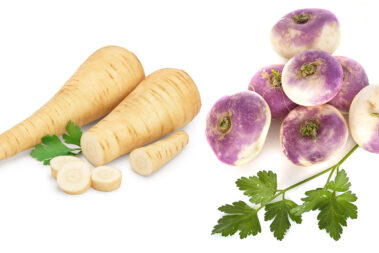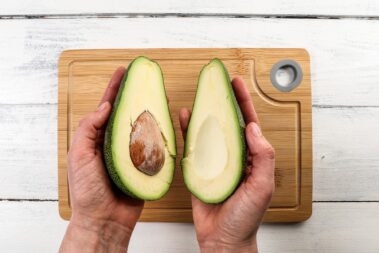Long thin stems. Delicate, serrated leaves. A strong odor. And one of the most common fresh herbs in the culinary world.
Am I describing cilantro or parsley?
Both, actually! And that is why so many people have a hard time keeping these popular herbs straight. But a few overlapping features don’t mean these two foods can be easily interchanged or even that they share the same health benefits or overarching flavor.
Table of Contents
Primary Difference
The primary difference between cilantro and parsley is the flavor. Aside from adding vibrant color, parsley has a delicate, fresh taste that brings balance and deepens the flavors of other ingredients. By contrast, cilantro has a bold, citrusy flavor that many people love, but some people can’t stand as it reminds them of soap.
To find out more about what separates these spindly greens and why some people love one but hate the other, we’ll have to take a deeper look at each herbs’ origin, nutritional profile, and culinary use.
The Details: Plant Type and Origin
Both cilantro and parsley are part of the Apiaceae family, which also includes celery and carrots. While they hail from the same taxonomic group, they each have a slightly different origin and place in human history.

Parsley
Parsley is native to the Eastern Mediterranian but has been widely cultivated all over the world and can be found growing wild in most parts of Europe. The plant is completely edible with some types grown for their flavorful leaves and others for their thick carrot-like taproot.
It is believed that parsley was first cultivated in Sardinia around the 3rd century BC. It has remained a popular ingredient in Mediterranian cooking and is also widely used in Asia and America.

Cilantro
The technical term for the cilantro plant is coriander. But in the US, it is typical to refer only to the seeds of the plant by that name and the plant itself by its Spanish name. If that isn’t confusing enough, the plant is also known around the world as “Chinese parsley.” (“Italian parsley,” on the other hand, is just another variation of true parsley.)
Cilantro originated in the regions of Southern Europe, Northern Africa, and Southwest Asia. Cilantro has been cultivated and used by humans as medicine and in food for far longer than parsley, with descriptions of the herb found in texts as old as 1550 BC. The plant was even found preserved in Tutankhamen’s tomb.
Nutritional Profile and Health Benefits
Despite a shared taxonomy and physical appearance, there are actually a number of nutritional differences between cilantro and parsley. Though, both pack an extraordinary amount of antioxidants and health-affirming nutrients and it’d be hard to say which is healthier.
Parsley
Parsley is high in vitamins A, C, and K and is an especially great choice for women due to its high folate and iron contents. Though, extremely high amounts of parsley should be avoided by pregnant women due to the herb’s uterotonic effects, which can cause contractions.
In addition to protecting heart and bone health, parsley can also help keep blood sugar levels under control. Myricetin, a powerful antioxidant, can lower blood glucose and reduce insulin resistance through its antiinflammatory actions.
This herb is also easy on the stomach and is known to help reduce bloating. This may be one of the reasons a sprig of parsley has traditionally been served as a garnish with large meals.
Another reason for chowing down on that green twig meant to decorate your plate? Parsley has demonstrated antibacterial properties against pathogens like Listeria and Salmonella and may be capable of reducing your risk for food poisoning.
The antioxidants in parsley can help fight cancer, reduce inflammation, and prevent chronic disease. Interestingly, if you want to take full advantage of these benefits, opt for the dry herb over the fresh leaves as studies have shown that, pound for pound, dried parsley has a 17 times greater antioxidant load than fresh.
Cilantro
Like parsley, cilantro is loaded with vitamins and antioxidants and is great for bone, eye, and heart health. Cilantro also contains a flavonoid called quercetin that is known to reduce oxidative stress and inflammation. This is an especially valuable antioxidant for those that suffer from autoimmune diseases like type 1 diabetes.
This herb is also uniquely detoxifying. Cilantro contains a substance that binds with heavy metals like lead and mercury to safely remove them from the body. So next time you have a craving for fish, try to incorporate some latin flare with a zesty cilantro salsa or creamy cilantro chutney to neutralize any heavy metals lurking in the meal.
Like parsley, cilantro can also be a valuable herb for type 2 diabetics. It has enzymatic effects in the body that can help with glucose processing to reduce blood sugar. Similar effects also help to reduce cholesterol and blood pressure.
Cilantro extract has been shown to reduce anxiety and may even help you find a more restful night’s sleep. Similar to parsley, the herb can have beneficial effects on the digestive system and prevent food poisoning.
Culinary Uses
While it isn’t impossible to use cilantro in place of parsley in some recipes (and vice versa), the fact is, these two similar herbs have very different tastes. In fact, there are some people who absolutely detest the taste of cilantro but love parsley.
Let’s look at the flavor profile and culinary uses of these two herbs and dig into the (very scientific) reason some people love one but not the other.
Parsley
Compared to cilantro, parsley has a mild flavor with spicy, yet lemony-fresh notes. Curly leaf parsley has the least flavor of the varieties and is often used as a garnish due to it’s attractive leaf structure. Flat leaf parsley, on the other hand, has a bolder taste and thinner leaves that tend to be more palatable when raw.
Parsley is best known for its role in Italian cuisine, but it is used widely in American, Asian, Indian, and even Brazilian dishes. This herb is often cooked with the other ingredients rather than being added at the end of the prep process (with the exception of garnishes, of course).
Here are some of our favorite recipes that incorporate parsley:
- Vegan Meatballs
- Chickpea Salad Sandwich
- Easy Vegan Lettuce Wraps
- Veggie-Filled Curry
- Vegan Eggplant Parmessian
Cilantro
Cilantro has a much more in-your-face flavor than parsley and can easily overpower a dish if you let it. Like parsley, it has some lemony undertones, but is most defined by its deep, earthy flavor. Because much of this flavor is lost when heated, cilantro is generally added at the end of the cooking process or put on top of the meal afterward.
Cilantro is popular in Central Asian and Indian cuisine but may be best known for its use in Mexican dishes. Salsas, guacamole, tacos, even Mexican rice wouldn’t be the same without the bold, fresh flavors provided by the cilantro.
For most, cilantro is a delightful addition to many meals, assuming it doesn’t overwhelm the recipe. But for some, the taste of this herb is anything but appetizing. In fact, they’d describe it as “soapy.” Interestingly, this isn’t so much a matter of taste as it is a matter of genetics. Some people carry a variation in their olfactory receptor genes that cause this strange perception of cilantro’s flavor.
Here are some of our favorite recipes that are made infinitely better with cilantro:
- Mexican Street Corn Burger
- Slow Cooker Chili
- Jackfruit Tacos with Avocado Lime Sauce
- Simple Vegan Taco Salad
- Spring Roll Bowl with Savory Peanut Sauce
How to Properly Store Parsley and Cilantro
Regardless of whether you find cilantro soapy or satisfying, it is important to know how to properly store fresh herbs if you want to use them in your cooking more often.
To keep your greens looking and tasting their best, fill a mason jar with about an inch of water and put the herbs in stem side down, making sure to pinch off any leaves that might be submerged. Keep the jar in the fridge and change the water out every few days.
If you are serious about keeping your parsley and cilantro fresh, you may even consider purchasing an herb keeper.
- How to Pick the Perfect Watermelon For a Sweet Summer Treat - April 10, 2024
- Future Kind’s Foundations: A Multivitamin Made for Vegans - December 5, 2023
- Does Nutritional Yeast Go Bad? - November 28, 2023







